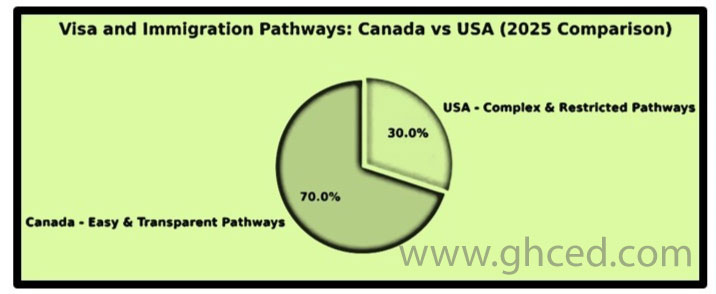Introduction
Over the past few years, the global education landscape has undergone a remarkable transformation. For decades, the United States stood as the primary destination for ambitious students seeking world-class universities and career opportunities. However, as international priorities evolve, a noticeable shift has taken place — Canada has emerged as the new academic powerhouse attracting students from every corner of the world who are looking to study in Canada 2025..
This growing preference for Canada is not a coincidence; it reflects the country’s consistent commitment to accessible education, cultural diversity, safety, and long-term success through clear Canada PR pathway options. With Canada university rankings among the world’s best, student-friendly Canada student visa policies, and strong job prospects via Post-Graduation Work Permit (PGWP) eligibility and PGWP changes 2025, Canada has become a symbol of opportunity and balance.
In an era where students look beyond just academics — valuing lifestyle, inclusivity, and real-world experience such as the ability to work while studying in Canada — Canada stands out as a destination that perfectly blends quality education with a high standard of living. Top programs, including STEM programs Canada, also help students select top courses for PR in Canada.
As we move into 2025 and beyond, this trend continues to redefine how students choose their international education paths. This article explores the major factors behind this global shift and reveals why Canada is increasingly becoming the smart, secure, and sustainable choice for students aspiring to build their future abroad, with guidance from the GHC Education Canada Guide.
1. A Shift in Global Education Trends
Since 2020, Canada has witnessed a significant rise in international student enrollment. According to recent IRCC reports (2025), over one million international students are currently studying in Canada — a record high.
Today’s students are not just looking for degrees; they are seeking value, safety, and long-term opportunities. Canada is meeting all three expectations by offering high-quality education, a welcoming environment, and strong post-study prospects.
For students planning their journey, resources like the GHC Education Canada Guide provide essential information on exams, eligibility, and guidance for studying abroad.

2. Affordable Education with High Academic Value
One of Canada’s greatest advantages is affordability. While U.S. universities can cost between USD 30,000–60,000 per year, Canadian universities typically range between CAD 15,000–30,000. This allows students to pursue affordable study in Canada while accessing world-class education, earning globally recognized degrees, and benefiting from excellent academic quality.
| Category | Canada | United States (USA) | Key Insight |
|---|---|---|---|
| Average Tuition Fee (Undergraduate) | CAD 15,000 – 30,000 per year | USD 30,000 – 60,000 per year | Canada offers nearly 50% lower tuition fees for equivalent degree programs. |
| Average Tuition Fee (Postgraduate) | CAD 17,000 – 35,000 per year | USD 35,000 – 70,000 per year | Graduate programs are more affordable and research-oriented in Canada. |
| Living Expenses (Accommodation, Food, Transport) | CAD 10,000 – 15,000 per year | USD 18,000 – 25,000 per year | Canada’s lower cost of living supports financial stability for students. |
| Work During Study | Up to 20 hrs/week (part-time) | Up to 20 hrs/week (part-time) | Both allow part-time work, but Canada has simpler employment policies for students. |
| Post-Graduation Work Permit (PGWP/OPT) | Up to 3 years (PGWP) | Up to 1 year (OPT), STEM: 3 years | Canada’s PGWP offers longer and more flexible career opportunities. |
| Permanent Residency (PR) Options | Clear pathways via Express Entry, PNP | Limited through employer sponsorship | Canada’s immigration system is student-friendly and transparent. |
| Quality of Education | Globally ranked universities with modern learning models | Long-standing Ivy League and tech institutions | Both are high-quality, but Canada focuses more on accessibility and innovation. |
| Safety and Inclusivity | Highly safe and multicultural | Safe but regionally varied | Canada provides a more welcoming environment for international students. |
Read the full article here: Germany Overtakes US & Canada: Paradigm Shift in Global Education Trends.

3. Simplified Visa and Immigration Pathways in Canada 2025
Canada is recognized worldwide for its transparent and student-friendly visa system, making it the top choice for international students seeking a secure and promising academic future. With streamlined visa processes, post-study work options, and clear pathways to Permanent Residency (PR), Canada provides more than just education — it offers a future.
Fast and Efficient Student Visa: Student Direct Stream (SDS)
The Student Direct Stream (SDS) simplifies the visa process for students from countries such as India, China, the Philippines, and Nigeria. Key advantages include:
- Faster visa approvals for eligible applicants
- Simplified documentation requirements
- Greater planning confidence for academic journeys
With SDS, students can stay focused on their studies without worrying about delays or complicated paperwork.
Learn more here 👉 Building a Healthier Future
4. Canada vs. USA: Visa and Work Opportunities
When comparing Canada and the United States, international students find Canada offers more stable and predictable pathways. Canada’s Post-Graduation Work Permit (PGWP) is a major advantage for international students. Graduates from Designated Learning Institutions (DLIs) are eligible for up to three years of open work experience, providing:
- Exposure to Canadian industries
- Opportunities to enhance global career prospects
- A bridge from education to permanent employment

| Feature | Canada | USA |
|---|---|---|
| Post-study work | Up to 3 years via PGWP | 1 year OPT; STEM extension possible |
| Permanent Residency (PR) | Express Entry & PNPs | Limited options for F-1 visa holders |
| Work while studying | Up to 20 hours/week | On-campus only; limited off-campus work |
| Visa clarity | Transparent, predictable process | Complex, uncertain, employer-dependent |
For a comprehensive understanding of these pathways and how to navigate them, refer to the detailed guide here: Turning Setbacks into Opportunities: Study Abroad & PR Pathways

Clear Pathways to Permanent Residency
Canada provides structured routes to Permanent Residency (PR) for international students:
- Express Entry: For skilled graduates and workers
- Provincial Nominee Programs (PNPs): Regional pathways tailored to local labor needs
These pathways allow students to build a career and settle in Canada, a feature few countries offer as effectively.
5. Canada vs. USA in Long-Term Value
Why International Students Prefer Canada?
- Fast and predictable visa approval via SDS
- Work opportunities while studying (up to 20 hours/week)
- Up to 3 years of post-graduation work via PGWP
- Clear pathways to Permanent Residency under Express Entry and PNPs
- Inclusive policies supporting international talent retention
Canada’s education and immigration system reflects diversity, inclusivity, and opportunity, giving students a world-class education and a strong foundation for a prosperous future. To explore these opportunities, check out the detailed guide here: AI and Emerging Technology Programs Abroad for Commerce and Business Graduates.
| Feature | Canada (PGWP & PR System) | USA (OPT & H-1B System) |
|---|---|---|
| Post-Study Work | PGWP (Up to 3 Years) | OPT (1–3 Years, job/field-specific) |
| Job Requirement | No job offer needed for permit application. | Job offer required to start work. |
| PR Pathway | Clear, points-based: CEC and PNP offer high-probability pathways after 1 year of work. | Lottery-based: Requires winning the annual H-1B visa lottery, which is highly competitive and uncertain. |
| Long-Term Stability | Secure and predictable. Leads to long-term career growth and citizenship. | High uncertainty. Risk of being forced to leave after OPT if the H-1B lottery is not won. |

6.Core Benefits: Safety and Social Advantage
- Global Safety Leader: Ranked consistently among the Top 15 Safest Countries (Global Peace Index) with significantly lower violent crime rates than the U.S.
- High Quality of Life: Top-ranked globally for Quality of Life, supported by universal healthcare and strong political stability.
- Official Multiculturalism: Government policy actively fosters social cohesion, ensuring an inclusive environment where students from 200+ ethnic origins feel valued.
- Seamless Integration: Rapid adaptation for newcomers due to strong cultural support networks and an inherently welcoming society (cities are among the most multicultural in the world).
- Future-Proof Skills: Exposure to this diverse setting develops critical cross-cultural communication skills, enhancing global employability and career competitiveness.
7. Balanced Lifestyle and Work-Study Flexibility
Canada encourages students to balance education, work, and personal life. International students in Canada can legally work up to 20 hours per week during semesters and full-time during breaks, providing both financial support and real-world experience. In 2025, Canada continues to pilot flexible work-hour policies in key sectors — an innovation highly valued by students. Students can refer to resources such as Smart Spending Abroad: A Financial Guide for Indian Students for guidance on budgeting, managing living expenses, and making informed financial decisions while studying in Canada.
8. Research, Innovation, and Future Skills
Canadian universities are global leaders in research and innovation. Institutions such as the University of Toronto, University of British Columbia, and McGill University are recognized for their contributions to technology, sustainability, and healthcare. Canada’s academic focus on practical learning and emerging technologies ensures students develop skills aligned with future career demands.
9. Quality of Life and Student Support Systems
Canada’s world-class cities rank high for quality of life, healthcare, and sustainability. Universities and colleges offer dedicated student support offices, mental health programs, and career services that help learners succeed both academically and personally. This supportive environment helps students build confidence and thrive during their study abroad journey.
10. Global Recognition and Career Growth
Canadian degrees are respected worldwide and hold strong employment value across industries. Employers appreciate graduates’ bilingual skills, multicultural awareness, and practical experience gained through co-op and internship programs. These attributes make Canadian graduates highly competitive in the global job market.
11. The Future of International Education
Education is evolving — and Canada is leading this transformation. The combination of affordable education, diversity, and innovation positions Canada as a top global education hub. As more students seek holistic, career-driven education abroad, Canada’s steady growth proves it is ready to shape the future of international learning.
12. Conclusion: Canada — The Smart Choice for a Brighter Future
Choosing Canada means choosing a country that values education, opportunity, and global connection. With transparent immigration systems, supportive pathways such as the Post-Graduation Work Permit (PGWP), and strong job markets, Canada has become the ideal destination for international students in 2025 and beyond.
Beyond academics, Canada’s inclusive policies and multicultural environment ensure that students feel welcomed while gaining practical experience and career-ready skills. For those dreaming of studying abroad, Canada represents not just a destination, but a future built on growth, stability, and long-term success.
FAQs
The Canadian Advantage: Your Future Starts Here
1. Why has Canada surpassed the USA as the top study destination in 2025?
Canada leads due to its combination of superior public safety (ranked among the Top 15 globally), better overall affordability, and a clear, attractive Permanent Residency (PR) pathway post-graduation.
2. Is Canada more affordable than the US for international students?
Generally, yes. Canada offers competitive and often more affordable average tuition fees at public institutions, coupled with a typically lower overall cost of living than major US cities, providing excellent financial value.
3. What is the Post-Graduation Work Permit (PGWP), and why is it crucial for my PR application?
The PGWP allows graduates from eligible institutions to gain up to three years of Canadian work experience. This is the single most valuable factor for boosting your immigration score (CRS) and qualifying for Permanent Residency programs like the Canadian Experience Class (CEC).
4. What are the latest PGWP eligibility changes international students must know for 2025?
As of November 2024, students in certain non-degree programs (college diplomas/certificates) must ensure their field of study aligns with Canada’s long-term labour shortage occupations (e.g., STEM, Healthcare) to be PGWP-eligible. University degree graduates (Bachelor’s, Master’s, PhD) are not affected.
5. Which courses in Canada offer the highest demand and clearest PR pathways?
Programs in Healthcare and Social Services, STEM (Computer Science, Engineering, AI), and certified Trades are highly favored. These fields are prioritized by recent government updates to directly address long-term labor market shortages.
6. How does Canada's top global safety ranking benefit me as an international student?
Canada consistently ranks among the Top 15 safest countries globally, maintaining significantly lower violent crime rates than the U.S. This high standard of public safety ensures a secure, worry-free environment, giving both you and your family peace of mind.
7. Are Canadian degrees respected worldwide, and how does this affect my global job prospects?
Absolutely. Canadian degrees are respected worldwide and employers value graduates for their technical skills, bilingual capability, and invaluable cross-cultural awareness—attributes that make you highly competitive in the international job market.
8. What is the maximum duration of the PGWP, and how can I secure it?
Completing a program of two years or longer generally qualifies you for the maximum 3-year PGWP. Shorter programs may yield permits matching the study duration. Eligibility depends on graduating from a Designated Learning Institution (DLI).
9. How does Canada's official policy of multiculturalism help me integrate quickly?
Canada’s official policy actively fosters an inclusive environment. With over 200 ethnic origins represented, you can quickly find support networks and cultural touchpoints (language, food, events), ensuring a seamless transition and accelerated social integration.
10. Can I work part-time while studying in Canada to manage my expenses?
Yes, as a full-time international student, you are typically authorized to work off-campus up to 20 hours per week during regular academic sessions and full-time during scheduled school breaks.
11. Are significant scholarships and financial aid available for international students in Canada?
Yes, numerous Canadian universities and provincial governments offer merit-based and entrance scholarships to attract top international talent. Consulting with GHC Education helps you identify and secure these opportunities.
12. Which English language tests (IELTS/TOEFL) are commonly accepted by Canadian institutions?
Both IELTS and TOEFL are widely accepted. The minimum requirement for most programs typically ranges between IELTS 6.0 to 6.5 overall.
13. What is the biggest difference in the application process between Canadian and US universities?
Canadian universities often place more emphasis on academic scores (GPA), while key elements like the Statement of Purpose (SOP) and Letters of Recommendation (LORs) are critical for securing admission in both countries.
14. Can my spouse or common-law partner work while I study in Canada?
Yes, a major Canadian advantage is that your spouse or common-law partner is often eligible to apply for an Open Work Permit (OWP), allowing them to work for any employer in the country while you complete your program.
15. Why should I choose GHC Education to guide my study abroad journey to Canada?
GHC Education provides comprehensive, expert support—from course selection and visa guidance to navigating the complex PGWP and PR applications—guaranteeing the fastest, most informed, and successful route to achieving your international career aspirations.
Your path to a healthier future starts today — connect with GHCED and let us help you transform ambition into achievement.
📞 Call or WhatsApp: India 🇮🇳 +91-9791118875 / Canada 🇨🇦 +1 506 639 1457
📧 Email: info@ghced.com
🌐 Website: www.ghced.com
🏢 Offices: 🇮🇳 INDIA – Chennai | Bangalore | Hyderabad | Delhi | 🇨🇦 CANADA
Disclaimer:
This information is a general guide based on recent trends and rankings. Please confirm all current details regarding immigration policies, safety statistics, and university programs on official Canadian government and institutional websites before making any study decisions, as rules and data can change.



